- Home
- Susan Wittig Albert
Widow's Tears
Widow's Tears Read online
WIDOW’S TEARS
China Bayles Mysteries by Susan Wittig Albert
THYME OF DEATH A DILLY OF A DEATH
WITCHES’ BANE DEAD MAN’S BONES
HANGMAN’S ROOT BLEEDING HEARTS
ROSEMARY REMEMBERED SPANISH DAGGER
RUEFUL DEATH NIGHTSHADE
LOVE LIES BLEEDING WORMWOOD
CHILE DEATH HOLLY BLUES
LAVENDER LIES MOURNING GLORIA
MISTLETOE MAN CAT’S CLAW
BLOODROOT WIDOW’S TEARS
INDIGO DYING
AN UNTHYMELY DEATH
CHINA BAYLES’ BOOK OF DAYS
Cottage Tales of Beatrix Potter Mysteries by Susan Wittig Albert
THE TALE OF HILL TOP FARM
THE TALE OF HOLLY HOW
THE TALE OF CUCKOO BROW WOOD
THE TALE OF HAWTHORN HOUSE
THE TALE OF BRIAR BANK
THE TALE OF APPLEBECK ORCHARD
THE TALE OF OAT CAKE CRAG
THE TALE OF CASTLE COTTAGE
Darling Dahlias Mysteries by Susan Wittig Albert
THE DARLING DAHLIAS AND THE CUCUMBER TREE
THE DARLING DAHLIAS AND THE NAKED LADIES
THE DARLING DAHLIAS AND THE CONFEDERATE ROSE
With her husband, Bill Albert, writing as Robin Paige
DEATH AT BISHOP’S KEEP DEATH AT EPSOM DOWNS
DEATH AT GALLOWS GREEN DEATH AT DARTMOOR
DEATH AT DAISY’S FOLLY DEATH AT GLAMIS CASTLE
DEATH AT DEVIL’S BRIDGE DEATH IN HYDE PARK
DEATH AT ROTTINGDEAN DEATH AT BLENHEIM PALACE
DEATH AT WHITECHAPEL DEATH ON THE LIZARD
Nonfiction books by Susan Wittig Albert
WRITING FROM LIFE
WORK OF HER OWN
SUSAN
WITTIG ALBERT
WIDOW’S TEARS
BERKLEY PRIME CRIME, NEW YORK
THE BERKLEY PUBLISHING GROUP
Published by the Penguin Group
Penguin Group (USA) Inc.
375 Hudson Street, New York, New York 10014, USA
USA / Canada / UK / Ireland / Australia / New Zealand / India / South Africa / China
Penguin Books Ltd., Registered Offices: 80 Strand, London WC2R 0RL, England
For more information about the Penguin Group, visit penguin.com.
This book is an original publication of The Berkley Publishing Group.
WIDOW’S TEARS
Copyright © 2013 by Susan Wittig Albert.
All rights reserved. No part of this book may be reproduced, scanned, or distributed in any printed or
electronic form without permission. Please do not participate in or encourage piracy of copyrighted
materials in violation of the author’s rights. Purchase only authorized editions.
Berkley Prime Crime Books are published by The Berkley Publising Group.
BERKLEY® PRIME CRIME and the PRIME CRIME logo are trademarks of Penguin Group (USA) Inc.
Berkley Prime Crime hardcover paperback ISBN: 978-1-101-62220-9
An application to register this book for cataloguing has been submitted to the Library of Congress.
FIRST EDITION: April 2013
Cover illustration copyright © by Joe Burleson; Background © by Hemera/Thinkstock.
Cover design by Judith Murello.
Interior text design by Tiffany Estreicher.
PUBLISHER’S NOTE: The recipes contained in this book are to be followed exactly as written. The
publisher is not responsible for your specific health or allergy needs that may require medical supervision.
The publisher is not responsible for any adverse reaction to the recipes contained in this book.
This is a work of fiction. Names, characters, places, and incidents either are the product
of the author’s imagination or are used fictitiously, and any resemblance to actual persons,
living or dead, business establishments, events, or locales is entirely coincidental.
The publisher does not have any control over and does not assume any responsibility for
author or third-party websites or their content.
ALWAYS LEARNING PEARSON
For my friends in the Herb Society of America,
who have named me their
honorary president for 2012–2014.
China and I thank you.
Table of Contents
Note to the Reader
Prologue
Chapter One
Chapter Two
Chapter Three
Chapter Four
Chapter Five
Chapter Six
Chapter Seven
Chapter Eight
Chapter Nine
Chapter Ten
Chapter Eleven
Chapter Twelve
Chapter Thirteen
Chapter Fourteen
Chapter Fifteen
Chapter Sixteen
Chapter Seventeen
Chapter Eighteen
Chapter Ninteen
Chapter Twenty
Resources
Recipes from Thyme for Tea
The Symbolic Meanings of the Plants in Widow’s Tears
Note to the Reader
Flo-rig’-ra-phy (fl–o-rig’-ra-f–e), n. [L. flos, floris, flower + -graphy.] The language or symbolism of flowering plants, as expressed in historical literature.
Webster’s New International Dictionary of the English Language
People often ask me the question “What exactly is an herb?”
I’ve never liked questions that have to be answered “exactly,” because I appreciate a little ambiguity and mystery in my life—it makes things much more interesting. That’s why I like the Herb Society of America’s definition of an herb: “a plant for use and delight.” It’s an impossibly broad definition, yes. But it’s a definition that invites us to explore the widest possible uses of plants to provide taste, scent, medicine, fiber, dye, tools, artifacts, and symbols, from the distant beginnings of human culture to the present time.
Almost all societies have assigned symbolic meanings to plants. In China, for example, bamboo (which provides medicine, food, building materials, paper, and textiles) represents longevity, strength, and grace. In Hindu cultures, jasmine (used as a medicine, a flavoring, and a fragrance) symbolizes love, while once upon a time in the British Isles, green willow symbolized untrue or immature love.
Throughout human history, these symbolic meanings have been elaborated in art, poetry, and literature. During the early Victorian period, for instance, wealthy and leisured ladies and gentlemen frequently exchanged floral gifts in which a fanciful “language of flowers” was encoded. As Kathleen Gips puts it in her introduction to Flora’s Dictionary: The Victorian Language of Herbs and Flowers, “people expressed flowery thoughts by exchanging bouquets composed of carefully chosen plant words.”
The definitions of these encoded “plant words” or floral symbols—collectively, a florigraphy—were published in Europe and America in an enduring and highly popular literary tradition made up of dozens of elaborate manuals that appeared in multiple editions. At their best, these were attractive, leather-bound volumes with gilt-edged pages and engraved illuminations, occasionally hand-colored. At the end of this book, you’ll find some suggestions for further reading that will lead you deeper into the study of florigraphy and its many historical transformations. It’s a subject that many garden and literary study groups might find interesting.
Of course, while herbs and plants are an important thematic and plot element in the books in the series (it’s amazing how many mysteries there are in the lives of plants!), you’re probably even more interested in the characters. China Bayles, of course, has alway
s been front and center, with her herb shop, her lawyerly logic, and her tendency to be drawn into…well, murder. And, of course, Ruby Wilcox has never been far behind, playing the role of an intuitive Dr. Watson to China’s logical Sherlock.
But now it’s Ruby’s turn to play Sherlock. Widow’s Tears is her story—and it’s about time, don’t you think? We’ve already learned about her shop, her family (the daughter she gave up for adoption and who reappeared in Hangman’s Root; the mom who has Alzheimer’s), and her everyday life. We know about her bout with breast cancer (in Mistletoe Man) and her adventures with the Ouija board (Rosemary Remembered and Bleeding Hearts). In Widow’s Tears, Ruby shows us just how good she is at looking deeply into mysteries that are hidden from everyone else—even from China. To help while Ruby is doing this, Dawn Zudel of Columbia, Tennessee, (the winner of Story Circle’s character raffle) has volunteered to tend her shop. Thanks, Dawn!
Widow’s Tears is also the story of the Great Galveston Hurricane, which forms the historical backdrop against which Ruby’s story unfolds. The hurricane—to this day, the deadliest natural disaster to hit the United States—struck Galveston Island on September 8, 1900. It killed some eight to twelve thousand people (nobody really knows how many), wiped out whole families, and changed the destiny of the city of Galveston, which at the time rivaled Houston for the position of the most important city in Texas, indeed, on the entire Gulf Coast. I have created a fictional character, Rachel Blackwood, through whom to tell the story of the hurricane. But Rachel’s story is based on the real stories of hurricane survivors recorded in many documents of the period. I’ve listed my sources in the resource section at the end of this book.
An important reminder: throughout the China Bayles series, you will read many descriptions of the therapeutic uses of plants, both modern and historic. China and I fervently hope that you will seek informed, reliable advice before you decide to use any of these herbs to treat whatever ails you. Medicinal plants are “natural,” yes, but plant chemistry is not always well understood—and the more we understand, the more cautious we are likely to be. Many herbs have potent side effects, especially when combined with over-the-counter and prescription drugs. Do your own careful homework and use all medicines, plant-based or otherwise, with mindful attention. China and I would not like to lose any of our readers—especially you.
Susan Wittig Albert
Bertram, TX
Prologue
Galveston, Texas: The Oleander City
Saturday, September 8, 1900
The coast of Texas is according to the general laws of the motion of the atmosphere exempt from West India hurricanes and the two which have reached it followed an abnormal path which can only be attributed to causes known in meteorology as accidental…. It would be impossible for any cyclone to create a storm wave which could materially injure the city [of Galveston].
“West India Hurricanes”
by Isaac M. Cline, Chief Meteorologist
Texas Section, U.S. Weather Bureau
Galveston Daily News, July 16, 1891
Rachel Blackwood got up early that morning. She had not slept well: her youngest daughter, three-year-old Angela, was suffering from a sore throat and had cried often for her mother in the night, needing to be soothed.
But it wasn’t just Angela’s whimpers that had disturbed her mother. It was the thunder of the waves on the beach that had kept her awake—and the heat, the unspeakable, unbearable heat. According to the daily newspaper, the Galveston News, sultry weather had smothered almost the whole of the country that summer, from the Rockies east to Pennsylvania, from the Great Lakes south to the Gulf of Mexico. Thirty people in New York City had died one awful August Saturday. Dozens of others had succumbed in Chicago and Memphis, and at the St. Louis zoo, two bears and a leopard had been felled by the heat.
On Galveston Island, summers were usually cooled by ocean breezes, and the miles of shining white-sand beaches, groves of palm trees, and extravagant flower gardens made the city seem a paradise. But this year, summer in paradise had been marred by both sultry heat and unusual rains. During July and August, tropical storms had drenched the city—sixteen inches of rain in one downpour, nine inches in another. Boys sailed the flooded downtown streets in wooden tubs, fish flopped across lawns, mothers despaired of ever getting the laundry dried in the damp air. And there were the morning fogs, and the foghorn in the lighthouse on the Bolivar Peninsula, a forlorn ghost calling, calling, calling through the dim gray mist.
The Blackwood household—Rachel; her husband, Augustus (the newly appointed vice president of the Galveston National Bank); the five Blackwood children and their fifteen-year-old nurse, Patsy; and Mrs. O’Reilly, the family’s longtime cook-housekeeper—seemed to be moving in a languid and stuporous dream that summer, half-asleep under a sweltering blanket of humidity and heat. The thermometer on the back porch had registered 90 on Thursday and 91 on Friday, and when Rachel had taken the children the four blocks to the beach, they had complained that the Gulf was as warm as bathwater.
The morning air was cooler, though, and for the first time in weeks, Rachel could draw a deep breath as she slipped out of bed and dressed. But she had awakened to the strange, unsettled sense that something was different, something was…menacing. She went down to the kitchen to oversee Mrs. O’Reilly’s breakfast preparations and review the plans for Matthew’s birthday supper that evening. Then out to the garden to pick an armful of dewy white roses and rosemary sprigs and the last few pink oleander blooms for the bowl on the table in the morning room. But all the while, she could not shake the feeling of apprehension. And even as she arranged the flowers in a crystal bowl, wondering once again why white roses were supposed to signify sadness when the rich scent of their silvery petals gave her so much pleasure, she was uneasy. Perhaps it was Angela’s worrisome illness, or the rising north wind, unusual for September, that made a peculiar whistling in the eaves. Or the pounding of the surf that seemed much louder now than when she’d gotten up, and the tremors of the wooden floor under her feet.
Rachel had occasionally felt the floor trembling during Gulf storms, although it had never been quite so pronounced as now. The Blackwood house was located on Q Avenue, just off Bath Avenue, only three blocks from the white-sand beach. The highest ground in the island city, on Broadway, rose only 8.7 feet above the Gulf, and some (perhaps remembering that Cabeza de Vaca had named the island Malhado, “misfortune”) had cautioned that a strong storm would flood the entire city. A seawall had been proposed as early as 1874 and several times since, but was considered to be too expensive and unnecessary. Isaac Cline, a noted meteorologist and chief of the Weather Bureau’s Texas Section (and the Blackwoods’ neighbor on Q Avenue), had written in the News that it was “simply an absurd delusion” to believe that Galveston could be seriously damaged by a tropical storm. The city was protected by “the general laws of the motion of the atmosphere.”
Nevertheless, many prudent Galvestonians built their houses on pilings, and Rachel’s husband, Augustus, was one of these. He had ordered his house to be constructed atop wooden piers driven deep into the island’s sandy soil, ensuring that it would stand well above the highest of storm tides, locally called “overflows.” As he explained to Rachel, it was the piers, standing eight feet above the surface, which transmitted the shudder of the waves against the beach to the floors of the house. The trembling, he said with a confident smile, was in fact a token of the strength and security of its anchorage to the earth.
Indeed, it was not just a secure and solid house but a splendid house, as befitted a man of Mr. Blackwood’s rank among Galveston’s men of finance. It was a large, three-story towered and turreted Victorian, with a drawing room where Rachel served tea to the ladies who called every afternoon and a library filled with Augustus’ fine collection of books and a music room fitted out with a Steinway grand piano. There was a magnificent oak staircase, fireplaces with gleaming marble mantels, and glorious stained glass windows
in the dining and drawing rooms, commissioned from the Tiffany Glass and Decorating Company. The opulent furnishings and draperies, all in exquisite taste, had been brought from as far away as Paris and New York.
Painted a sober brown with red trim, this fine house was set back from the street behind a wrought iron fence, a border of oleanders and hollies, and a row of date palms, which in the late summer produced an abundance of fruit. The steps up to its wide front gallery were guarded by twin stone lions, each head turned to gaze thoughtfully at the other. The heavy bronze knocker on the oak front door wore the enigmatic face of Neptune, the god of the deep. And the steep slate roof was crowned with a wooden-railed widow’s walk that offered a panoramic view of the island paradise and the vast blue-green Gulf stretching to the eastern horizon.
But while Mr. Blackwood prized his house for its solidity, its splendor, the beauty of its furnishings, and the view from its roof, Rachel prized it for far more. It was the home of her heart. It held all that was dear to her—Augustus and her children: stalwart Matthew, ten years old this very day; sweet in-between Ida; the five-year-old mischievous twins, Peter and Paul; and dear baby Angela. To Rachel’s great delight, the children were all very musical. Just the night before, they had all gathered in the music room. Matthew, a gifted young pianist, played the “Maple Leaf Rag” on the Steinway—Scott Joplin’s song was wildly popular everywhere. Then Rachel accompanied the children in one of the family’s favorite songs, “Sweet and Low,” while Matthew played his flute, Ida played her harp, and Peter and Paul sang sweetly. Baby Angela, in her little red-painted rocking chair, laughed and clapped her hands. On the sofa, Augustus read his newspaper, smoking his favorite cherry tobacco. Rachel thought then that she had never been so happy. She could not know that she would never be happy again.
Since the house had been recently built, it made all sorts of interesting new-house noises, murmurs and sighs and groans as the pilings and joists and beams and rafters settled into place. All five of the children insisted that the house talked to them. Rachel often made an amusing little game of it with them, asking what the house was whispering today, what secrets it had to tell, what stories it wanted to hear. With giggles and great delight, they would tell her what the house had to say—oh, such miraculous tales of intrigue and mystery! And then they would run to whisper their stories into the waiting ears of the stone lions that guarded the steps, for the lions were their dear friends and would keep them safe always, just as the house kept them safe.

 Hemlock
Hemlock Chile Death
Chile Death The Tale of Briar Bank
The Tale of Briar Bank Widow's Tears
Widow's Tears The Tale of Oat Cake Crag
The Tale of Oat Cake Crag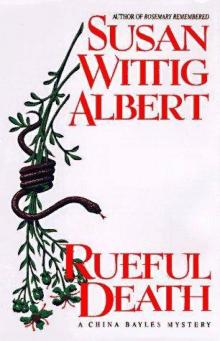 Rueful Death
Rueful Death Bittersweet
Bittersweet The Darling Dahlias and the Poinsettia Puzzle
The Darling Dahlias and the Poinsettia Puzzle A Wilder Rose: A Novel
A Wilder Rose: A Novel Spanish Dagger
Spanish Dagger The Darling Dahlias and the Texas Star
The Darling Dahlias and the Texas Star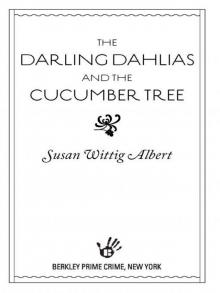 The Darling Dahlias and the Cucumber Tree
The Darling Dahlias and the Cucumber Tree China Bayles' Book of Days
China Bayles' Book of Days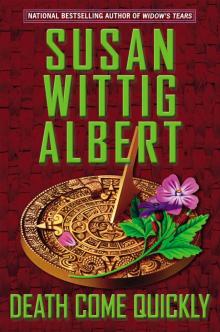 Death Come Quickly
Death Come Quickly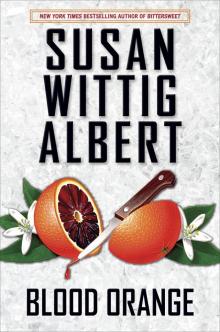 Blood Orange: A China Bayles Mystery
Blood Orange: A China Bayles Mystery Cat's Claw
Cat's Claw The Darling Dahlias and the Naked Ladies
The Darling Dahlias and the Naked Ladies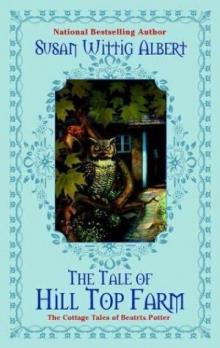 The Tale of Hill Top Farm
The Tale of Hill Top Farm The Darling Dahlias and the Confederate Rose
The Darling Dahlias and the Confederate Rose The Darling Dahlias and the Silver Dollar Bush
The Darling Dahlias and the Silver Dollar Bush The General's Women
The General's Women Dead Man's Bones
Dead Man's Bones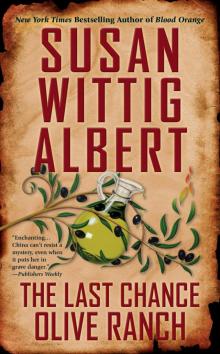 The Last Chance Olive Ranch
The Last Chance Olive Ranch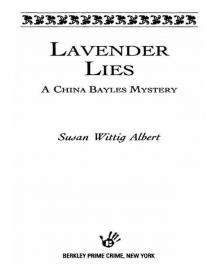 Lavender Lies
Lavender Lies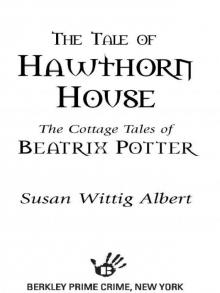 The Tale of Hawthorn House
The Tale of Hawthorn House The Tale of Castle Cottage
The Tale of Castle Cottage Rosemary Remembered - China Bayles 04
Rosemary Remembered - China Bayles 04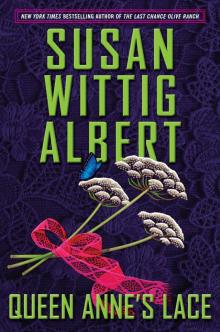 Queen Anne's Lace
Queen Anne's Lace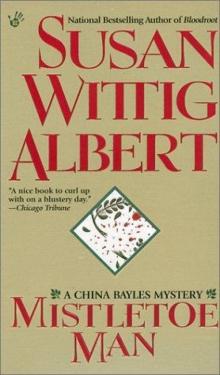 Mistletoe Man - China Bayles 09
Mistletoe Man - China Bayles 09 The Darling Dahlias and the Unlucky Clover
The Darling Dahlias and the Unlucky Clover Mourning Gloria
Mourning Gloria The Darling Dahlias and the Eleven O'Clock Lady
The Darling Dahlias and the Eleven O'Clock Lady